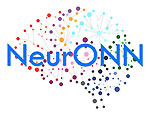Neuro-inspired computing architectures are one of the leading candidates to solve complex and large-scale associative learning problems for AI applications. The two key building blocks for neuromorphic computing are the neuron and the synapse, which form the distributed computing and memory units. In the NeurONN project, we are proposing a novel neuro-inspired computing architecture where information is encoded in the “phase” of coupled oscillating neurons or oscillatory neural networks (ONN).
Specifically, VO2 metal-insulator transition (MIT) devices and 2D memristors will be developed as neurons and synapses for hardware implementations. We predict VO2 MIT devices are up to 250X more energy efficient than state of the art digital CMOS based oscillators, where 2D memristors are up to 330X more energy efficient than state of the art TiO2 memristors. Moreover, the predicted energy efficiency gains of ONN architecture vs state of the art spiking neural network (SNN) architecture is up to 40X.
Thus, NeurONN will showcase a novel and alternative energy efficient neuromorphic computing paradigm based on energy efficient devices and architectures. Such ONN will demonstrate synchronization and coupling dynamics for establishing collective learning behavior, in addition to desirable characteristics such as scaling, ultra-low power computation, and high computing performance.
NeurONN aims to develop the first-ever ONN hardware platform (targeting two demonstrators) and complete with an ONN design methodology toolbox covering aspects from ONN architecture design to algorithms in order to facilitate adoption, testing and experimentation of ONN demonstrator chips by all potential users to unleash the potential of ONN technology.
